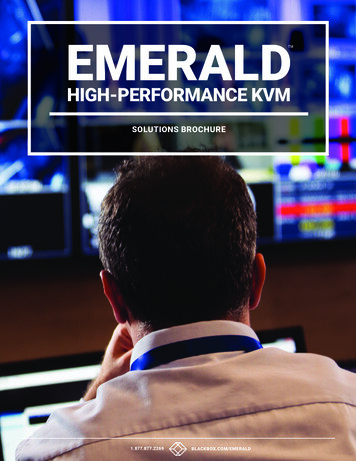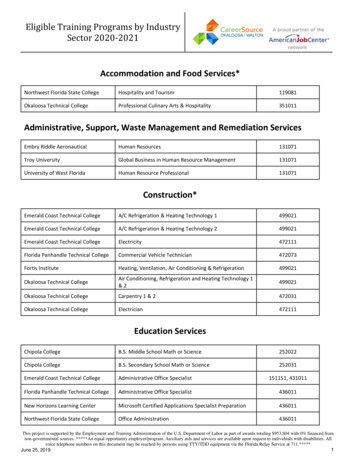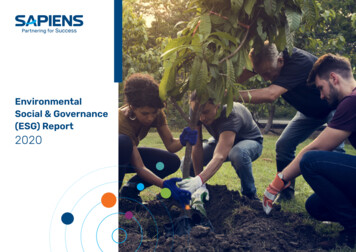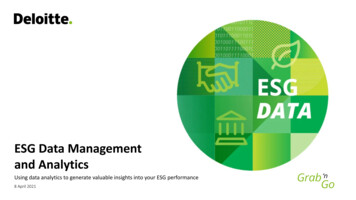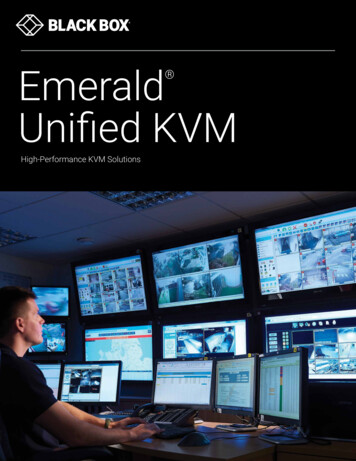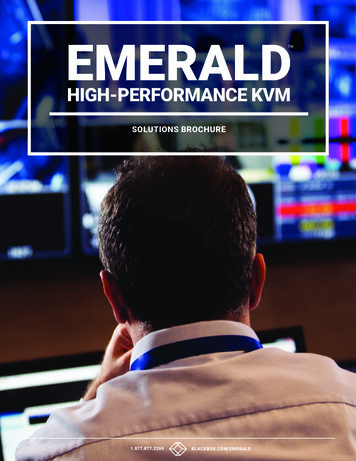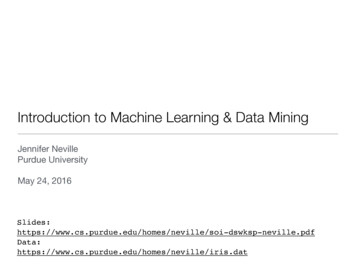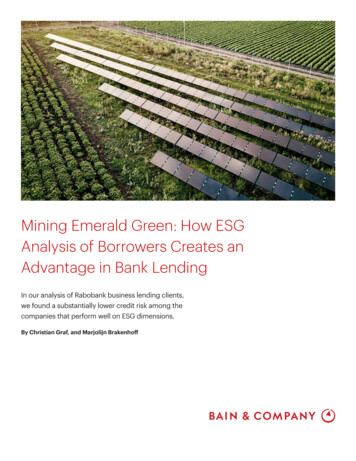
Transcription
Mining Emerald Green: How ESGAnalysis of Borrowers Creates anAdvantage in Bank LendingIn our analysis of Rabobank business lending clients,we found a substantially lower credit risk among thecompanies that perform well on ESG dimensions.By Christian Graf, and Marjolijn Brakenhoff
Copyright 2021 Bain & Company, Inc. All rights reserved.
Mining Emerald Green: How ESG Analysis of Borrowers Creates an Advantage in Bank LendingAt a GlanceAs enthusiasm for ESG spreads, analysis of its effect on the credit risk of private companies hasbeen thin—until Bain and Rabobank delved into the bank’s commercial loan portfolio.Bain found that clients with low ESG performance were about twice as likely to be in arrears asthe high ESG performers, all else equal.The correlation holds over time even when controlling for size, profitability, and levels of debt,and even when companies start from the same risk rating.Banks can use such analysis as the basis to ultimately improve their client management, riskassessments, loan pricing, and funding.Corporate credit with terms pegged to companies’ environmental, social, and governance ratings hastaken hold. Europe is at the forefront, but other regions are rapidly catching up. For example, BNPParibas has signed ESG-linked loan deals with JetBlue Airways, packaging company Crown Holdings,and engineering consultancy WSP Global. Tokyo-based bank SMBC has a similar deal with the USarm of Japanese tire company Bridgestone.Recent developments in capital markets also indicate a relationship between sustainability andshare price performance. Stocks with higher ESG ratings have outperformed the market and showngreater resilience, a correlation that has persisted through the Covid-19 pandemic.While investment performance of public companies is well researched, analysis of the credit risk ofprivate companies has been thin. Recently, however, Bain & Company applied statistical analysis to alarge, representative sample of commercial customers in Rabobank’s loan portfolio. Our work confirmsa strong relationship between customers’ sustainability practices and lower risk of being in arrears(see Figure 1).The ESG-risk connectionRabobank gathered ESG information from its 20,000 small and medium-size enterprise clients, usingquestions specific to their particular industries. Manufacturers, for instance, were asked whetherthey reused or cleaned waste and water, and which energy-saving measures they took. Agriculturalclients were asked about land management and animal welfare. External data such as eco-certificationscorroborated the account manager assessment.Using this data, Bain ranked the companies’ ESG performance on a scale of 0 to 100 and analyzedthe differences between the top ESG performers and the bottom ones. We used a propensity matching1
Mining Emerald Green: How ESG Analysis of Borrowers Creates an Advantage in Bank LendingFigure 1: Stronger performance on ESG dimensions correlates with lower credit riskShare of Rabobank’s commercial loan clients in arrears, for one 81%–100%ESG score as percentage of maximum scoreSources: Rabobank; Bain analysisanalysis to control for other factors that can confound results, such as company size, profitability, andlevels of debt. For example, more profitable companies have lower risk and more money to invest inESG initiatives, so we applied the propensity analysis to elicit a pure ESG-risk relationship.We found that clients with low ESG performance were about twice as likely to be in arrears as thehigh ESG performers, all else equal. This effect is statistically significant. Separately, we investigatedthe ESG-risk relationship over time. Low ESG performers were about twice as likely as high performersto move into arrears over the year, even when they started from the same risk rating (see Figure 2).These results indicate a correlation between higher ESG performance and lower credit risk, which forthe Rabobank portfolio holds across different geographies and industries. We will continue to investigate the connection between sustainability and credit risk, using data over a longer period andpossibly more control variables.The role of managementExactly why sustainability correlates with lower risk is difficult to prove statistically, because of thequalitative factors involved. Interviews with account managers, combined with our experienceworking with other banks on ESG-related initiatives, suggest that the quality of management playsan important role.2
Mining Emerald Green: How ESG Analysis of Borrowers Creates an Advantage in Bank LendingFigure 2: The correlation holds even when companies start from the same risk ratingShare of Rabobank's commercial loan clients that moved into arrears, starting from the sameaverage risk rating the prior year2%–4%1%–2%Low ESG performersHigh ESG performersSources: Rabobank data; Bain analysisHigher-caliber management establishes business models that foster financial stability and sustainability. Such investments can lead to greater operational efficiency, by reducing by-products andwaste and by more efficiently allocating resources. In turn, efficient resource allocation improves afirm’s financial health and lowers its default risk.For example, Rabobank sees that Dutch organic grocery chain Ekoplaza actively focuses on reducingfood waste by optimizing its supply chain and donating produce that is almost out of date. Overall,the bank’s ESG-focused clients tend to have more efficient, long-term-oriented operations and thuspose a lower credit risk for the bank.Using ESG analysis to improve the business of lendingGiven the durable connection between sustainability and risk, banks have an opportunity to improvetheir lending business through client management, risk assessments, loan pricing, funding, and, inthe future, potentially capital models.Advanced client management. Client dialogues should expand to cover how performance on ESGdimensions affects the risk of default or falling into arrears, as well as the long-term benefits. Thechoice of clients can start with companies that have a relatively low ESG score but strong financials3
Mining Emerald Green: How ESG Analysis of Borrowers Creates an Advantage in Bank Lendingand senior managers willing to make changes. A bank can steer this effort centrally by, for instance,focusing on industries in which regulation or customer priorities call for ESG initiatives.Enhanced risk assessment. Adding in-depth analysis of ESG variables will increase the accuracy ofrisk models, enabling banks to make more informed judgments about each client’s risk profile. Anda better assessment of credit risk can give banks a competitive edge.Adjusted loan pricing. Financial incentives will help motivate clients to invest in sustainability. Rabobank has reduced the price of loans to high ESG performers such as Ekoplaza. Better pricing couldserve as a commercial strategic advantage for banks.Improved funding cost. Funds have already been made available for ESG investment from sources suchas Europe’s central banks. The latest initiative includes a fund launched by the Bank for InternationalSettlements for green-bond investments by central banks. Investor demand for sustainable assetscurrently outstrips supply, so a bank that can securitize and sell its ESG-intensive loans will be ableto obtain cheaper funding.Longer term, we imagine that further analysis, such as a time series,of the possible causality between sustainability and credit risk couldconvince regulators to allow banks to hold less capital against loansto companies with high ESG metrics.Longer term, we imagine that further analysis, such as a time series, of the possible causality betweensustainability and credit risk could convince regulators to allow banks to hold less capital againstloans to companies with high ESG metrics. Many banks clearly want to further ESG goals in their own and their clients’ activities. Recently, 43major banks formed the Net-Zero Banking Alliance, convened by the United Nations to support thetransition of the real economy to net-zero emissions. Rabobank’s experience should give banks confidence that they can help attain these lofty goals, and improve their economics in the bargain, byanalyzing and working with the private companies in their own portfolios.4
Bold ideas. Bold teams. Extraordinary results.Bain & Company is a global consultancy that helps the world’s most ambitiouschange makers define the future.Across 61 offices in 38 countries, we work alongside our clients as one team with a shared ambition toachieve extraordinary results, outperform the competition, and redefine industries. We complementour tailored, integrated expertise with a vibrant ecosystem of digital innovators to deliver better, faster,and more enduring outcomes. Our 10-year commitment to invest more than 1 billion in pro bonoservices brings our talent, expertise, and insight to organizations tackling today’s urgent challengesin education, racial equity, social justice, economic development, and the environment. We earned agold rating from EcoVadis, the leading platform for environmental, social, and ethical performanceratings for global supply chains, putting us in the top 2% among other consulting firms. Since ourfounding in 1973, we have measured our success by the success of our clients, and we proudly maintainthe highest level of client advocacy in the industry.
For more information, visit www.bain.com
ining Emerald Green ow ESG Analysis of Borrowers reates an Advantage in Bank ending Higher-caliber management establishes business models that foster financial stability and sustain-ability. Such investments can lead to greater operational efficiency, by reducing by-product
